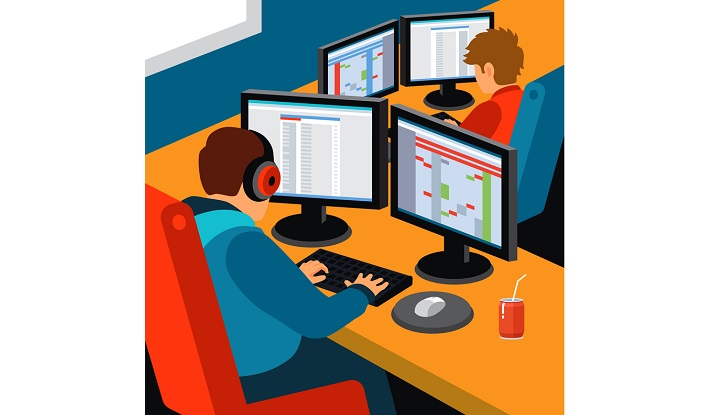
- Collaborative Writing - Home
- Collaborative Writing - Introduction
- Lowry's Theory
- Construction Theory
- Engagement Theory
- Pattern Theory
- Collaborative Writing - Applications
- Collaborative Competency
- Collaborative Writing at Workplace
- Collaborative Writing - Methodology
- Editing Strategy
- Collaborative Writing - Software
Collaborative Writing - Quick Guide
Collaborative Writing - Introduction
Collaborative Writing is used to describe those written work projects that involves multiple writers taking participation in writing and completing the work. It is different from shared writing in the manner of its execution, i.e. in shared writing, people divide the respective areas of work among themselves and focus on those areas itself.
What happens in collaborative writing, though, is that multiple writers are employed to complete the task and these writers have overlapping domains of responsibilities. This means that writers have the authority to go through the content you have written and suggest changes that you may or may not implement.

A day-to-day example of this could be the Wikipedia entries, which are written by people, edited by admins and changes are suggested by readers. In a truly collaborative writing environment, each writer has equal abilities and authority to engage in tasks of writing, editing, suggesting changes, removing text, and adding some more.
This makes the best product come out in the end as multiple recursive processes run on a written text before it is published. Collaborative writing encourages a series of changes in written text, so that a consensus emerges on accuracy of text.
Scope of Collaborative Writing
Professional writing is one such requirement that can be found in a variety of professions, organizations and department. Because of the quick availability of high-quality task, Collaborative writing is now being used in many fields ranging from education and remote-learning, because it has been observed that people pay more attention to a text when they are given the powers to edit the text if they dont agree to it.
This brings out a healthy debate as the original writer is made to share reliable sources to support his claim. This improvement of content based on mutual interaction makes the final product agreeable to all. While some of these documents are planned, drafted, revised and edited by a single author, most business reports and significant shorter communications are either formally written in groups or are reviewed by key readers in a company.

Industry experts reportedly state that about 87% of workplace writers submit their task through collaboration instead of isolated writing stretches. A professional collaborative writer needs to have the competency in language, skills and knowledge on the subject that provides him the ability to engage in collaborative writing.
Collaborative Writing - Lowry's Theory
Collaborative writing and its effects have been studied by researchers and business experts for years now. Depending on the observation of these researchers, numerous theories and working models have come up. According to Paul Benjamin Lowry, a common vocabulary must be conceptualized that different people working in a team or teams, can use to communicate in Collaborative Writing.
He says that in the absence of this common vocabulary, teams put into collaborative processes and left to themselves to get the work done will make a heavy waste of resources like time, efforts and money. Keeping these factors in mind, he propounded five collaborative writing strategies, which are −
- Single Author Writing
- Sequential Single Writing
- Parallel Writing
- Reactive Writing
- Mixed Mode Writing
Let us now discuss each of these collaborative writing strategies in detail.
Single Author Writing
Single-author writing occurs when one person represents an entire team writing collaboratively. This type of writing is usually practiced in law firms, when the lawyer employs a team to do all this research and paperwork, while he himself bears responsibility for the accuracy or fallibility of the mentioned facts.
Sequential Single Writing
In Sequential single writing, a group of writers work on individual areas of a writing project, but in a sequence. It means that the responsibility of writing is shared by the members of a team in a numerical sequence. The writer who is supposed to start with the writing, will complete his part and then pass the document to the second in sequence.
Parallel Writing
Closely resembling shared writing in method and implementation, parallel writing involves employing a group of people who are handed different portions of the document and are asked to work on their areas at the same time. There are two kinds of parallel writing, one where the document is divided into smaller sections and different members handed writing responsibilities of these sections.
The other one is where the team-members involved in the writing process are handed different roles. For example, proofreading, fact-checking, typo-correction, etc.
Reactive Writing
Reactive writing involves different team-members or various teams going through one anothers output and reacting to the content by suggesting changes, proof-reading, fact-checking, editing, etc. This is considered a healthy practice and ensures a credible written document.
Mixed Mode Writing
In the mixed mode of writing, some or all the above modes are incorporated into the writing process. For example, a team may have its team-members arranged in a sequence of writing, so while the first writer will be writing his part of the document, the rest might engage in reactive writing on it. When the first few writers are done with their tasks, they can become reactive writers in turn.
Collaborative Writing - Construction Theory
Javier Onrubia and Anna Engel carried out a research study with three student groups engaging in Collaborative Writing on four to eight written products. After analyzing the strategies that these teams used while preparing the written text, they identified four distinct yet interrelated processes of knowledge construction. These processes are as follows −
- Parallel Construction
- Sequential Summative Construction
- Sequential Integrating Construction
- Integrating Construction
Let us now discuss these four processes in detail.
Parallel Construction
Each group member is asked to work on a different part of the document and in the end, the final document is formed out of juxtaposing of these different parts. In another scenario, the document was divided into different portions and distributed among each teammate. After the writer had submitted his part of the document, smaller portions of text were selected from these and juxtaposed to form the final document.
Sequential Summative Construction
One team member, usually a senior presents a partially-completed document with different sections made out and partially fulfilled as per the style, technique, verbiage, and specifications required. The rest of the team is then entrusted with the responsibility to complete the writing on the different sections and submit the final complete document.
Sequential Integrating Construction
One team member presents a partially-complete or complete document to the team, upon which the rest of the team suggest changes, provide justified modifications or engage in discussions on the part they agree in the document or not. There is a successive contribution to the document.
Integrating Construction
The difference between Sequential Integrating Construction and Integrating Construction is that in the latter case, the changes and modifications are suggested during the writing of the document, as opposed to waiting for the document to be submitted for the contribution process to start.
Collaborative Writing - Engagement Theory
Stephen M. Ritchie and Dona Rigano interviewed a science teacher who, as the head of the department, wanted to reform the education model of their schools. By comparing his belief system to the consents, concessions, negotiations, trade-offs and rejections that the teacher received on his ideas from the rest of the science teachers, Ritchie and Rigano were able to identify two levels of engagement between the team members in implementation. They are −
- Turn Writing
- Lead Writing
Turn Writing
This form of writing is more cooperative where authors contribute to different sections, bringing changes and additional modification, which are then checked, implemented and collated by the lead writer.

Lead Writing
Two or more specialists on a topic are given a text to compose, who then speak their thoughts and others bring amendments into it which polishes and refines the text. The final text is then written down by another team member acting as a scribe. When the topic is done with, one of these specialists will act as a scribe and other teammates who are experts in the current subject will voice their thoughts.

Collaborative Writing - Pattern Theory
Lisa Ede and Andrea Lunsford researched on the significance of the audience of the text. They postulated a theory called the Audience Addressed vs. Audience Invoked, which debates the possibility of there being a pre-existing audience for any work of a writer, whom he will address through his work and whom he has to keep in mind while writing.
The other argument is that writers create their own audience and they dont need to keep the audience in mind while creating their content. Based on their observation and learnings, they theorized seven organizational patterns for collaborative writing, which include −
First Pattern
In this pattern, the entire team outlines and divides the task among team members, which each member then prepares and submits. The whole team then compiles the individual parts and revises the entire document.

Second Pattern
The team plans and outlines the writing task, however only one member partially drafts the document and the rest of the team edits, makes changes, modifies the document and does the final revision as well.

Third Pattern
In this working pattern, only one member of the team writes the final draft, which is then revised by the rest of the team. The difference between third pattern and second pattern is that, here the member writes the complete draft, not a partial one.

Fourth Pattern
One teammate outlines and writes the document. Once he is done, he will submit the document to other teammates, who may or may not consult the original author on the changes or modifications done.
Fifth Pattern
In the fifth pattern, the entire team collectively outlines and writes the draft and later one or more members revise the draft without consulting the rest of the team.
Sixth Pattern
The sixth pattern divides the team broadly into three parts −
- One supervising member who outlines, divides, and assigns task to the team-mates.
- A second supervisor who collects the completed tasks from the teammates and compiles them.
- The remaining teammates turn into writers.

Seventh Pattern
The seventh pattern also divides the team into three groups, where the first part dictates, the second part takes care of the transcription and the third part edits the resultant document and submits the final draft.

Ede and Lunsford found that the levels of satisfaction among team members working in different patterns change. Many people confess that they would like to be part of a writing process where the goals are clearly articulated and transparently shared.
They also noted the degree of mutual respect among the team members, the control writers have over their content, their level of engagement in the editing process, the manner in which credit is shared, conflict-management, constraints on the writer, and finally the significance of the project within the organization.
Example
Researchers have found that people learn more about different cultures through mutual interaction, as opposed to giving them inter-cultural lessons in training rooms. For example, some of the common collaborative tasks given in Spanish cultural sensitivity classes are −
Hispanic culture |
Team-mates collaboratively prepare a cultural report related to Hispanics, their geography, climate, economy, popular customs, and regional cooking) through mutual discussion. |
Vacation in Spain |
Teams collaborate and describe their idea of a vacation in Spain, and places to explore. The team is also asked to design an entire itinerary for the trip, inclusive of expenses on transportation, lodging and meals. |
Collaborative Writing - Applications
Nowadays, many writing assignments are impossible to imagine without having a collaborative writing team. For example, a major publication house desirous of publishing a book on Spanish Culture may get it written by a team of cross-cultural experts in India, but will get it revised by a team of writers in Spain too.
Collaborative writing and peer reviewing are different activities, because peer reviewing basically is a correctional, editing-based and criticism-oriented process that comes after the collaborative writing effort. However, both are related and are often conducted together, so peer reviewing has been made a part of collaborative writing.
Peer Evaluation
When handling a collaborative writing assignment, it is important to set the areas that a teammember can evaluate another teammates output. This decision is normally taken by the teamleader after a consultation with his team.

Some of the most common areas of evaluation are checking for completion, degree of cooperation and dependability on the writer, the amount of effort the writer put in his work and the quality of his output. The most important factor of them all is his adherence to deadlines.
As a team-leader, the person should have the ability to quickly outline a project and delegate different responsibilities to different team members or divide writing responsibilities among different writers in his team.
He should be able to motivate writers to keep writing when the process gets monotonous and should be able to resolve conflicts that frequently arise during the peer evaluation process.

In collaborative writing, the group assignment is designed in such a way that the entire team contributes in writing. This improves skills of leadership, planning, division of labor and responsibility-sharing among team members.
Planning is especially important because writers tend to work in isolation, which means they might not like to engage in frequent conversations and update-sharing. To manage collaborative writing assignments efficiently, a few factors are important to be kept in consideration. These factors are −
- The description of the project
- Success criteria
- Project outline
- Assigning of task evenly
- Equal responsibility-sharing
- Adhering to schedules
- Proper editing and
- Timely sharing of feedback
Collaborative Competency
Collaborative competency is not only important to learners, but also to companies that employ them. The whole idea behind running a company is to make sure that the product sells. Collaborative writers are expected to create opportunities for sales, marketing, relationshipbuilding and reliability through their writings.
Keeping this in mind, workplace writers need to hone sophisticated skills of communication through their written text. The demands for collaborative writing also is based on certain practical factors. For example, a business letter full of lengthy, complex Terms and Conditions could be quite challenging to write for any single writer.
Even if the person is an experienced campaigner, he wont be able to encapsulate all the absolute points needed to be put in the document and if he does, then he will take extra time to consider all the factors and elements. To avoid this congestion of ideas and time, the companies nowadays recruit collaborative teams to address the constraints economically and efficiently.
Often is the case where business environment dictates the collaborative process. For example, the writers are often instructed to write keeping in mind the mood of the general public and the general reviews that a product has received.
Benefits of Collaborative Writing
Collaborative process is used in political processes too, where two countries enter an agreement and everything they decide and agree upon reaches a consensus. In such sensitive cases, no single person from either country and no single country wants to be solely responsible for the drafting of such an important document.
In such cases, the collaborative writing process involves the best drafting teams from both the countries. That ensures a level playing ground where no country will be able to exploit any secondary interpretation of text later. Thats the reason all treaties today are drafted by a committee working on collaborative writing principles. A few more benefits of collaborative writing are listed below −
- Higher quality output, because various perspectives, skills and inputs of numerous writers.
- It is highly motivating to work in a team where participants try to outperform one another.
- Co-writers operate as critics and deliver valuable feedback during drafting.
- Writers of lesser experience get industrial exposure and experience working with senior writers.
- Better working relationship and coordination among team members.
- Unanimous acceptance of the final draft because of collaboration and feedback among members.
As you can observe, there are multiple scenarios where collaborative writing not only accounts for higher efficiency and reliability, but also is an indispensable necessity.
Pitfalls of Collaborative Writing
As with any creative process, there are times when highly-skilled people will have a difference of opinion. When such scenarios come, a collaborative team gets split into sub-teams very quickly and things go out of control, if the team leader doesnt respond to the situation quickly. Some of the pitfalls of collaborative writing are given below −
- Collaborative writing almost always struggles in case of political and social challenges.
- Coordination of collaborative process is very complex for a manager due to numerous writers.
- Collaborative writing is time consuming when it is on political processes and logistics documents.
- If all writers in the team are inexperienced, the documents wont be necessarily of higher quality.
- Cultural differences and conflicting styles of writing can be difficult to channelize into one voice.
- Personal conflict over authority, styles of working and seniority are sometime inevitable.
Some of the most common reasons for the failure of a collaborative team is the weakness of the most junior members of the team in grasping the concept and right approach. People might wonder the reason behind employing junior staff, if they can prove inefficient, but their appointment is subject to logistics and budget considerations.
In addition to that, communication issues like improper briefing and physical distance between the writers, frequent editing of teams also slows down the process and results in team failure.
Collaborative Writing at Workplace
When employees working in reputed organizations were interviewed, they confessed that most of their individual work also are results of them collaborating frequently with their colleagues. Research shows that the following actions are done the most by the collaborative writers −
- Outlining the plan and selecting a single person to draft the document.
- Reviewing, modifying, and providing feedback on the work of colleagues
- Participating in teams with shared authorship
- Ghostwriting for senior colleagues
Experts also mention the skills that are needed for a writer to be able to collaborate properly with other teams. The most important of the skills are active listening and self-reflection, which in this context will be read as self-reviewing.

Other skills include reliability, trust-building, the ability to take criticism without being overtly defensive, having a distinct voice yet acknowledging different perspectives, an ability of managing conflict and managing wrong assumptions and navigating it towards the right one.
Researchers also recommend that writers chalk out some practical strategies to handle different stages of writing process, such as conceptualizing, drafting, reviewing, etc. or to specific activities such as conflict handling etc.
How Collaborative Writing Encourages Idea-sharing
Collaborative writing should be used as an opportunity by the writers to engage different points of view, purposes and perceptions into the documentation process. They can do so by the use of technology like sending emails each other or sharing and merging documents.
For example, Microsoft Office Word has a very good feature Track Changes which keeps a record of the changes that individual writers are making to the document, along with the name of the editor or reviewer.

Most collaborative writing experts acknowledge that the existing model for collaborative writing was built keeping the academic education in mind. So to modify the technology and infrastructure to suit and help business needs, the working writers need to stay in contact with the academic communities, share their requirement and feedback with them, so that developers can keep all different suggestions for improvements while coming up with the best interactive tool.
Finding a Collective Voice
Studies of writing teams state that teams give high importance on outlining the practical applications of collaboration and finalizing the best practices like writing, reading, group management, etc. The concept of addressing an audience runs deep.
The most important concept for future collaborative practices will be to understand the viewership that the articles are going to get. It is important to realize how teams perceive and address their audiences.
Now, the audiences can be split into internal audiences (members of the team) and external audiences (non-organization people who are going to read the document). Will the writers get tempted to address the internal audience to gain clearance of their document even if the external audience has different expectations?
These questions are going to be asked more frequently as the collaborative writing process gets further spread and acceptance. Writers term this phenomenon as finding a consistent voice. This voice needs to be consistent with the business scenario or political compliance. Organizations manage to spread their voice through distributing memos, holding meetings, and arranging conferences.
Collaborative Writing - Methodology
While working on a major collaborative assignment, the writing team should first learn how to coordinate their tasks, by outlining a working model. The most common strategy is to assign at least two roles to each individual teammate, one can be related to writing and the other role related to the post-production, such as editing, scheduling, monitoring, etc.

This requires a high degree of professional conduct and interconnectivity of thoughts on behalf of everybody in the team. The most important thing to note is that, even if the roles of writing could be clearly chalked out, the other role could be flexible and overlapping.
In a collaborative writing structure, no person can be the sole partaker of any responsibility. An entire team can also be divided into sub-teams with specific roles such as −
Writer − All members in this team are responsible for writing and completing the document.
Group Leader − This group is responsible for the coordination of the team, scheduling and organization of actions.
Editor − This group will take responsibility to edit, insert style and proofread the documents, either in intervals or after the final documents submission.
Graphics Designer − This group is responsible for designing illustrations and the layout of hardcopy and Web printing of the document.
Subject Matter Specialist − This group takes care of researching on a topic and providing answers to queries of the team. They proofread the technical portions of the document for accuracy.
Webmaster − This team puts the contents of the document on the website and maintains it.
Determining which team member is fit for which job is the preliminary stage of any collaborative writing. In the first meeting itself, the members of the team get together and discuss their backgrounds and which areas they will be most comfortable working in. The team leader takes a note of the members technical writing skills, background, editing process and experience.

In subsequent meetings, the team outlines the project, delegates responsibilities and asks for submitting weekly informal progress reports in next meeting onwards. The team members can switch roles of note taking during subsequent meetings.
Collaborative Writing - Editing Strategy
When it comes to reviewing and revising the final draft, the team should design strategies that help them evaluate and edit the teams writing, such as implementing quality control measures, holding periodic reviews and sharing feedback. The feedback should be on whether the writing has −
- Accomplished its primary goal of addressing the readers uses.
- Identified and addressed all copyrighting and editing issues.
- Reviewed and edited all the final areas of the document.
As these meetings are held after parts of the document have been designed, the team will have to anticipate many issues that might crop up during the writing process, such as copyediting, grammar usage, content checking, etc.
After that, they will have to mention the project status, note the deviations, if any, from the initial plan and the list of actions that led to the difference between the first action plan and the current one. This process is divided into the following two segments −
- Review Draft
- Informal Progress Report
Let us know discuss these two segments in detail.
Review Draft
In this segment, the team will present their document, acknowledging the incomplete sections, and make space for them in the project.

In the later stages of their presentation, they will describe what will be mentioned in these spaces.
Every member of the team should have authority to review and evaluate the other members of the team.
The feedback should be short, precise and specific so that the members can act in an expedited manner.
The Informal Progress Report
The informal progress report can be structured like a weekly memo that gives a clear idea on the progress of the team. Members of the team should then initially sign each others progress reports.

The memo should address the following questions −
- Who attended the meeting?
- Who missed the meeting, and why?
- Was the list of items on the agenda discussed?
- What was the next sequence of action plans?
- What is the status of very participants involvement and progress?
These progress reports should include all the team members' names, their contact numbers, i.e. phone numbers and email addresses for easier contact.
Collaborative Writing - Software
All the best writers in the world at the moment writing for editorials nowadays use collaborative writing software. This helps them to get their work edited on the fly and also getting their ideas expressed in words much more impactful than theirs.
The constant refinement of their work through various levels of editing processes makes the creative process error-free and more comprehensive. It also adds charm and entertainment value to it. Keeping this factor in mind, many companies have come up with innovative online platforms like Editorially, for collaborative writing.
It helps writers tag friends to their documents which helps their friends to provide feedback on the document. However, Editorially had one gaping flaw it didnt allow two collaborative writers to edit the same document at the same time online, which actually defeated the concept of collaborative writing, especially while dealing with tech articles, where multiple chapters will be dedicated to numbers and formulae.
Once the writers got over Editorially, it has brought in a demand for new collaborative writing software. Experts on this subject have identified some important concerns that need to be addressed in any good collaborative writing software, some of these are −
- Free of Distraction
- Interactive support
- Annotation and discussion
- Document handling
- Import and export
Let us now discuss each of these concerns strategies in detail.
Free of Distraction
Writing is difficult when writers lose their chain of thought. As it is, writers are infamous for sliding into prolonged bouts of inactivity. So when a writer is hot on an idea, he shouldnt be disturbed by annoying pop-ups, notifications, annotations, etc. Golden rule is to help him when he looks for it.
Interactive Support
The software should make a writers interaction with the user interface as minimal as possible. This means there should be plenty of keyboard shortcuts and two-key combination commands.
For example, words sandwiched with hyphens (-this-) could make the text appear in italicized bold like this. The fonts should be easier to read too.
Annotation and Discussion
A true collaborative writing tool should not only assist during the writing process, but also help in sharing and editing content, while enabling discussion and review of the text. Collaborative teams must have provisions of highlighting or replacing text and track these changes. When working with multiple contributors, everyones remarks should be easy to spot.

Document Handling
A document can go through several revisions, so every change should be retraceable to the original draft. Reinstating of older text, formatting or changes is very important when a document is being written in a collaborative manner.
Import and Export
Finally, the software should be versatile and compatible enough to allow the writers to import any additional extension they want to incorporate into it. It should also allow usage of filesharing software like Dropbox, etc.
Conclusion
Learning the skills of writing a project in a collaborative manner in a team is considered as an invaluable asset in todays world. Many employers have already started giving prior importance to those employees who can handle collaborative writing assignments.
The future of organizations is in producing documents with shared authorship. They need to trust one another with sensitive, proprietary materials, so that they can work together in the future. The unique nature of collaborative writing will ensure that they develop greater cultural sensitivity and multiple viewpoints of drafting a document.
Everything said and done, it is in the best interest of everyone that everyone participates successfully into a collaborative team effort, as that is where the future of business writing is headed.